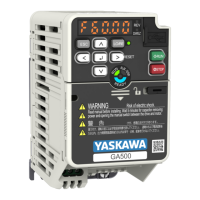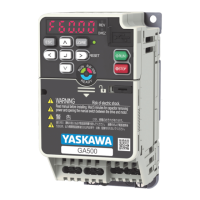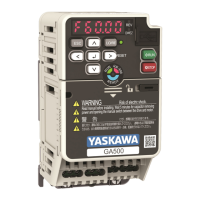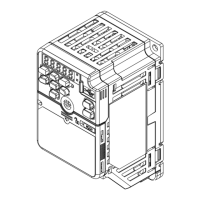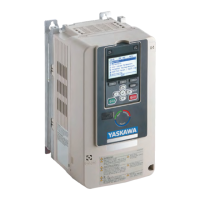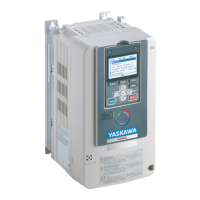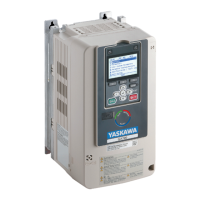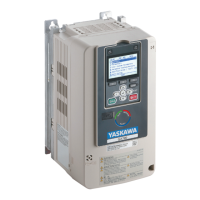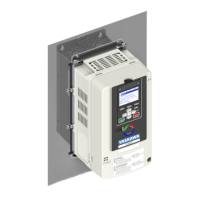Startup Procedure and Test Run
3
3.7 Fine Tuning during Test Runs (Adjust the Control Function)
YASKAWA TOEPYAIGA5002A GA500 Programming 483
Issue Parameter Number Possible Solutions Default Recommended Setting
• Unsatisfactory motor torque
and speed response
• Hunting or oscillation
C4-02 [Torque Compensation
Delay Time]
• If torque or speed response are
slow, decrease the setting value
in 2 ms increments.
• If hunting or oscillation occur,
increase the setting value in 10
ms increments.
Note:
Make sure that this parameter
setting is: C4-02 ≤ C4-06
[Motor 2 Torque Comp Delay
Time].
When you adjust C4-02, you
must also increase the n2-02
[Automatic Freq Regulator
Time 1] value by the same
ratio.
20 ms
*1
20 ms - 100 ms
*1
• Speed response is slow.
• Speed is not stable.
C3-02 [Slip Compensation Delay
Time]
• If speed response is slow,
decrease the setting value in 10
ms increments.
• If speed is not stable, increase
the value in 10 ms increments.
200 ms
*1
100 ms to 500 ms
Speed precision is unsatisfactory. C3-01 [Slip Compensation Gain]
• If speed is too slow, increase the
setting value in 0.1 unit
increments.
• If speed is too fast, decrease the
setting value in 0.1 unit
increments.
1.0
*2
0.5 to 1.5
• The volume of the motor
excitation sound is too high.
• Hunting or oscillation at low
speeds (10 Hz or lower)
C6-02 [Carrier Frequency
Selection]
• If the volume of the motor
excitation sound is too high,
increase the carrier frequency.
• If hunting or oscillation occur at
low speeds, decrease the carrier
frequency.
7 (Swing PWM1)
*3
0 to upper limit value
• Torque at low speeds (10 Hz or
lower) is not sufficient. speed
response is slow.
• Speed response is slow.
• Large initial vibration at start
up.
• E1-08 [Mid Point A Voltage]
• E1-10 [Minimum Output
Voltage]
• If torque or speed response are
slow, increase the setting value.
• If there is large initial vibration
at start up, decrease the setting
value
Note:
If you set the value too high,
the drive can output a large
torque reference although the
load is light.
• E1-08: 12.0 V
*2
• E1-10: 2.5 V
*2
Default setting +/- 2 V
*4
*1 The default setting changes when the settings for A1-02 [Control Method Selection] and o2-04 [Drive Model (KVA) Selection] change.
*2 The default setting changes when the settings for A1-02 [Control Method Selection] and E1-03 [V/f Pattern Selection] change.
*3 The default setting changes when the settings for C6-01 [Normal / Heavy Duty Selection] and o2-04 change.
*4 Recommended settings are for 200 V class drives. Multiply the voltage by 2 for 400 V class drives.
◆ Open Loop Vector Control for PM Motors
Table 3.16 Parameters for Fine Tuning the Drive (A1-02 = 5 [OLV/PM])
Issue Parameter Number Possible Solutions Default Recommended Setting
Unsatisfactory motor performance
E1-xx parameters, E5-xx
parameters
• Check the settings for E1-06,
E1-04 [Base Frequency,
Maximum Output Frequency].
• Check the E5-xx and make sure
that you set all motor data
correctly.
Note:
Do not set E5-05 [PM Motor
Resistance (ohms/phase)] to a
line-to-line resistance value.
• Do Auto-Tuning.
- -
Unsatisfactory motor torque and
speed response
n8-55 [Motor to Load Inertia
Ratio]
Adjust to align the load inertia
ratio of the motor and machine.
0 Near the load inertia ratio.
n8-45 [Speed Feedback Detection
Gain]
Decrease the setting value in
increments of 0.05.
0.80 -
C4-01 [Torque Compensation
Gain]
Adjust the setting value.
Note:
If you set this value too high, it
can cause overcompensation
and motor oscillation.
0.00 1.00
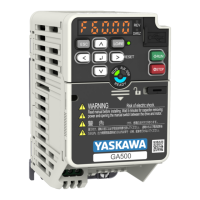
